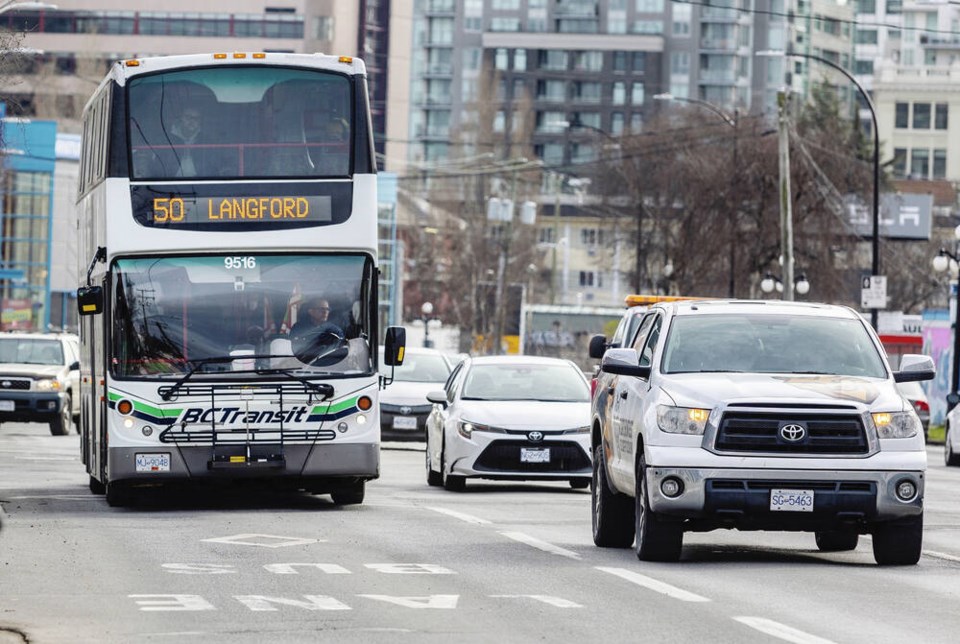A commentary by the vice-chair of Grumpy Taxpayer$ of Greater Victoria, a citizens advocacy group for municipal taxpayers.
A quarter-century ago, the province and 21 Metro Vancouver mayors created TransLink under the authority of the South Coast British Columbia Transportation Authority Act. The mayors recognized the obvious — governing effectively required a regional strategy to align regional property development with transportation infrastructure.
Today, when urban transportation matters even more, there’s still scant evidence of a co-ordinated and collaborative approach to transportation in Greater Victoria.
It’s also why Capital Regional District taxpayers pay health district property taxes annually — $24-million in 2022 — when residents of Metro Vancouver don’t.
It’s a pile of money.
The province amended the Hospital District Act, abolished their Hospital District Board and eliminated the Hospital District Property Tax (which funds some regional hospital capital costs).
The province then assumed the assets and liabilities of the former Hospital District in Metro Vancouver, according to an issue analysis by Colin Nielson, a board member with Grumpy Taxpayer$.
This allowed TransLink to increase its share of Metro Vancouver property taxes by the amount of the Hospital District tax, providing additional TransLink operations funding without raising overall property taxes.
Arguably, the CRD should be entitled to the same treatment as Metro Vancouver, provided the funds from Hospital District Property Tax are diverted to a similar transportation authority.
That would pump an immediate $24 million or so per year into transportation (based on Hospital District Taxes collected in the CRD in 2022), with no change in overall property taxation in the CRD.
That would provide a body to speak for, plan and prioritize transportation services and infrastructure for the region.
The capital region does not have the scale of traffic and development of Metro Vancouver, although similar transportation issues exist here.
Our region’s 13 municipalities have a provincially mandated Regional Growth Strategy but no regional transportation plan. Road planning is the responsibility of each municipality, including bridges and active transportation infrastructure.
The province is responsible for highways (Pat Bay, Trans- Canada, Highway 14, including interchanges and on/off ramps). B.C. Transit (a Crown corporation) provides bus service, with direction from the Victoria Transit Commission.
The province provides an annual operating grant to Victoria Transit and the Transit Commission determines the amount of the Municipal Transit Tax. The CRD owns some regional trails and is a member of the Island Corridor Foundation, which owns the controversial E&N Rail corridor.
While discussions occur from time to time at the CRD about forming a regional transportation authority — this will sound familiar — there has never been unanimous agreement from all 13 municipalities.
One of the major disadvantages of not having a regional transportation authority is the lack of a regional voice when seeking funding for transportation projects.
Examples include commuter rail services on the E&N and a sea bus service from Royal Bay to Victoria. A regional authority would give the CRD a means of reaching decisions and would provide a single voice when seeking senior government funding.
How would a Capital Region Transportation Authority work?
Roads are used by residents from across the CRD, but their infrastructure costs are not shared. It also includes an annual budget for cost-shared maintenance of a major road network with the municipalities through which those roads cross.
TransLink works with upper governments to identify important transportation needs.
By eliminating the Hospital District Property Tax in the CRD, $24,353,000 (based on 2022 statistics) would immediately be freed up, which could be directed to a transportation authority, without impacting overall property taxes.
This would require the province to treat capital region taxpayers the same as those in Metro Vancouver. It assumes that the province would continue to provide an annual operating subsidy to the Victoria Transit Commission, just as it provides operating funds to TransLink.
The timing to form a regional transportation authority couldn’t be better.
The newly-appointed Victoria transit commission chair, Sooke Mayor Maja Tait, told media she’s “committed to working with the CRD to set priorities and speak with a unified voice to senior governments.” A regional transportation authority will create more formality around the delivery of transportation services and help build and foster collaboration, Tait says.
CRD chair Colin Plant also supports the creation of a regional transportation authority. But a final decision rests with the CRD board and the Transit Commission.
Five government cabinet ministers call our region home.
While noticeable by its absence in the provincial budget, Transportation and Infrastructure Minister Rob Fleming expressed support for change at the Greater Victoria Chamber of Commerce on March 3, 2021, saying: “The solution [for better transportation governance] requires something other than the system of weighted votes used by the CRD. Greater Victoria needs a body that looks at the region as whole, and not as a collection of 13 municipalities.”
After a quarter century, let’s get on with it and work together as one community.
>>> To comment on this article, write a letter to the editor: [email protected]



